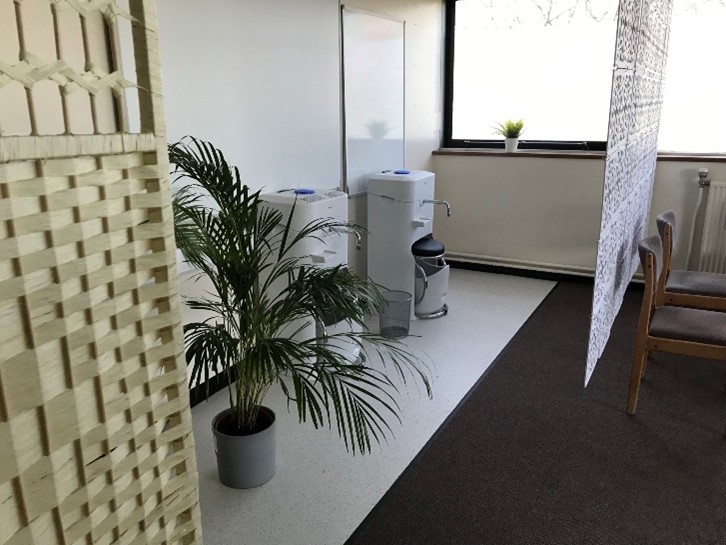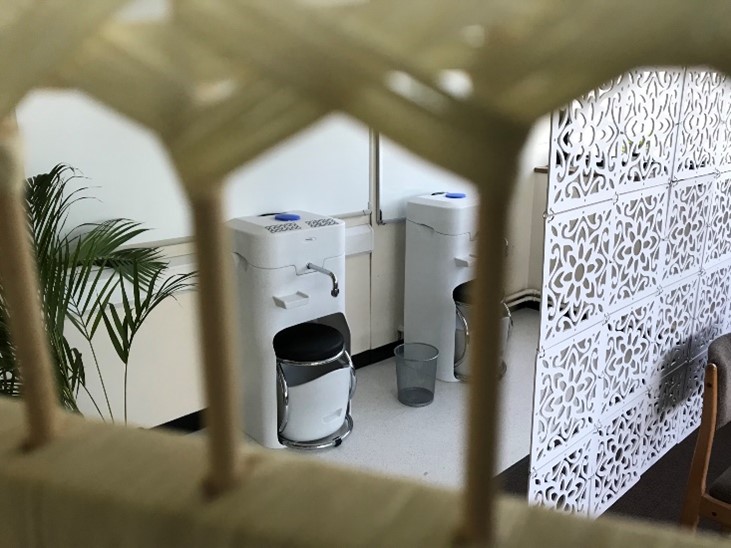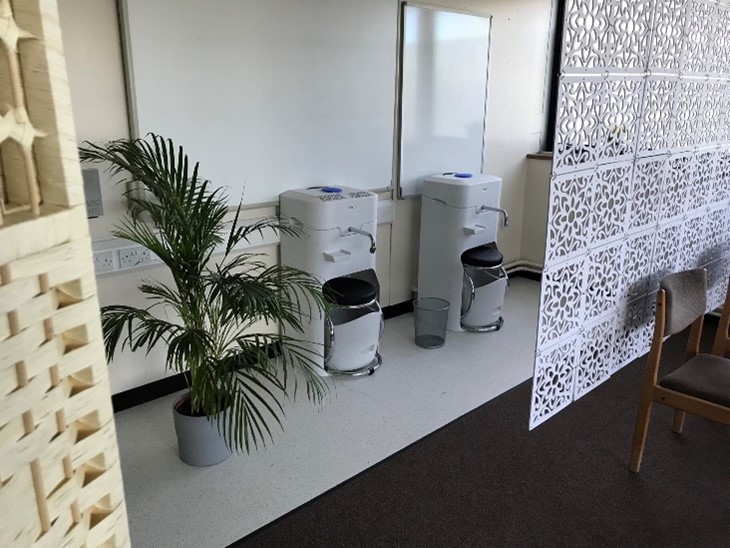It's possible that you have used one of our WuduMate units in your mosque, or if you have been visiting a public building and needed to pray while you are there.
I hope that you will agree that these units make the ablution process much more convenient and pleasant, compared to using traditional Western sinks.
Did you know that it is possible to have one of our WuduMates installed and plumbed in to your bathroom at home, or alternatively you can purchase a WuduMate Mobile for use at home, and use it in whichever room is most convenient to you and your family.
Please click on the image below and you will be able to download it as a pdf document, which you can keep and show to the other members of your family.
You can find out more about the units that we normally recommend for homes here:
If you would like more information about WuduMate for your home, please use this form and one of our sales team will be happy to answer any questions that you have.
A secondary school contacted us with a project to redecorate and refit their Multi-faith room. They decided to use WuduMate Mobile units and set aside a separate area of the room for wudu, separating it with a partition.
Our contact said "They are being used regularly by the students when they are in the Prayer room. They are really pleased with them and that we thought of them being able to carry out their rituals when praying. Thank you so much for your efforts in providing them for us."






This article is an extract from our booklet Diversity Matters - a guide to Best Practice in the Design of Multi-Faith rooms. To download a pdf copy of the full booklet, please click the image below
If you are planning a multi-faith room in your facility, the first thing you need to do is consider the cultural mix of potential users of your facility, and what they will be looking for if they wish to pray, read or meditate during the day.
Different faiths have different approaches to ritual duties and performance. For example, whilst Christianity is not demanding in terms of specific daily rituals, Islam requires Salat (prayers) be performed five times a day. This inevitably means that for proper observance, Salat will almost certainly occur at times during the ordinary working day.
If you have a significant number of Muslim users, it makes commercial sense to try to minimise the amount of unproductive time involved in getting to, using and returning from the prayer facilities provided. This can be achieved by having a multi-faith room close to individual work locations, in the same way as toilets are distributed for convenience around buildings.
Ideally, multi-building campuses should have a prayer room in each building, multifloored offices should have a faith room on each floor. A cost-benefit analysis would clearly demonstrate whether or not such an arrangement was justified with an overriding benefit being a saving of unproductive time, traveling to and from such facilities.
Having decided how many multi-faith rooms you need, and the location of them, there are several things you should take into account when designing each room.
The size of a prayer room should be commensurate with the number of people likely to use it at any one time. The requirements of Muslims are the most predictable, since their daily prayer routines take place at fixed times of the day determined by the times of sunrise and sunset. Furthermore, Salat follows a fairly fixed formula.
There are also defined times for Jewish prayer at least twice a day, again determined by dawn and dusk. However, there is more flexibility allowed to Jews who can usually pray early in the morning before work and in the later afternoon or early evening after work. Because the times for Muslim Salat are generally fixed, multi-faith rooms need to be large enough to accommodate all Muslim staff at one time,
It is unlikely that all Muslim staff will perform Salat every day, for example, females will not pray during their menstrual cycle, and prayer times on normal weekdays are more flexible than on Fridays, so it would be unlikely for all Muslim staff to be in the prayer room together. On Fridays however, it is obligatory for males to perform Salat in a group, similarly on days of Islamic significance (Eid and Ramadan).
Christians and adherents to most other faiths have no rigidly fixed times for daily prayers, so it is reasonable to assume that they would not choose to use the faith room during the times of Salat.
Each Muslim requires approximately 1.2m × 0.6m (4’ x 2’) of floor space on which to perform Salat. This enables them to place their forehead on the floor whilst kneeling, just touching shoulders with those on either side of them, so a prayer room should ideally be large enough to accommodate this number.
Provision needs to be made for ritual ablution prior to Salat (wudu) and this is discussed separately below. Ideally, entirely separate facilities for prayer and washing should be provided for Muslim men and women. However, if men and women are to share the same prayer room, women would normally stand behind the men separated by a curtain. In order to cater for varying numbers of men and women the curtain should be mounted on a moveable rail, so the position of the partition can be varied, alternatively, if no women are present, it can be removed altogether.
This same curtain partition would also be used by traditional Jews who pray publicly in a quorum of 10 men separated from any women present. It is entirely inappropriate to provide communal male and female washing facilities. Whether a single faith room or separate male/female rooms are provided, there will need to be separate washing facilities, unless the washing facility is behind a locked door to ensure privacy for women.
For most faiths there is no fixed direction in which prayers should be said although the cruciform footprint of older Christian churches follows a predictable orientation. Jews generally pray facing east towards Jerusalem. For Muslims however, it is mandatory for them to face the Ka’ba during prayer. This is an ancient religious site located in the city of Mecca. Although the prayer room itself does not have to be orientated in any particular way, there should be some indication in it of which direction each wall faces – specifically the direction of east and of the city of Mecca.
The exact direction of Mecca obviously depends on where in the world/country the faith room is located. A compass is available from most Muslim bookshops which indicates the exact direction of Mecca. An arrow, positioned on the ceiling is also recognised as a practical means of indicating this direction and can be purchased from WuduMate.
Ideally, the entrance to the room should be situated to enable worshippers to enter and leave the room without passing in front of those at prayer.
Cleanliness plays a significant part in most religions, but some faiths have a specific requirement for shoes to be removed before prayer. All visitors to the prayer room should therefore be encouraged to remove their shoes before entering. A sign to this effect should be displayed, suggesting to those who do not wish to remove their shoes that, out of respect to others, they should avoid walking across the main prayer area.
There should be an area where shoes can be removed prior to entering the faith room or associated washing areas, and a rack in which visitors can leave their footwear once removed.
It is not mandatory to have toilet facilities installed within a prayer room environment, however if they are included, it should be remembered that Muslims should not use a toilet facing the same direction in which they pray, i.e. facing Mecca. In addition, for a number of reasons, Muslim men will generally not use urinals, and prefer to urinate seated to standing, in the privacy of a toilet cubicle.
It is suggested therefore, that when planning the location and design of toilets in the workplace, if a higher-than-normal percentage of staff are likely to be Muslim, more cubicles and less urinals are provided than might be normal, and urinals are excluded altogether from multi-faith areas.
It should also be noted that some ethnic groups (including Muslims) require to wash their personal parts with water after using the toilet, rather than using paper, in other words, they require a private bidet facility.
The permanent presence of religious icons for one particular faith group can offend other religious groups and can create an atmosphere of ‘possession’ by one group. If the use of icons is specifically required by a particular religious group, there should be a cupboard for their storage when not in use. Ideally there should be a minimum of four such cupboards (to represent four of the major faiths).
There are cupboards available which look like bookshelves from the front, but when opened up have different designs inside; once the outer doors of the cupboard are opened, internal designs can include:
Furniture is not a mandatory requirement in a multi-faith facility, it is appropriate however to provide some informal seating for more casual visitors to use when reading or simply sitting in contemplation.
A simple table should also be provided for items required by some faiths as part of their ritual. Christians, for example, would appreciate the presence of a cross or crucifix to denote an altar. Jews might use a table for study, which is usual for them before, during or after prayer.
Ideally any furniture should be capable of being easily moved away from the central area of prayer. Such relocation should not be to the wall which people of particular faiths would face in prayer. The use of benches would be acceptable but there should also be some movable chairs for those who wish to sit at the table, or who find it difficult to kneel. The use of leather furniture should be avoided since Hindus cannot accept leather in their places of worship.
The covering of the prayer room floor should be in a neutral colour, so as to be acceptable to all faiths. It needs to be easy to keep clean.
Books and other religious publications such as calendars could be made available, but nothing should be left in permanent view, so as not to offend those of other faiths. It should instead be stored on a shelf or preferably in a cupboard. Material for promotional or advertising purposes should not be allowed.
Leather covered books should be avoided due to the offence caused by cow hide in religions such as Hinduism (see 5.6.2 above).
The prayer and washing areas should be well lit – ideally, in today’s environmentally aware world, with energy saving devices.
Windows will assist with the lighting and natural ventilation of the prayer room, but users might prefer obscure glass to be used. Stained glass windows can add to the aesthetic appeal of the décor, but the subject matter should be neutral with no religious connotations.
Prayer caps, mats, cushions and other items should be kept in cupboards so as not to cause offence. The burning of incense may contravene fire regulations and run the risk of activating smoke sensors and should be strongly discouraged.
If the use of candles is to be allowed, this should be closely monitored and supervised. Appropriate legislation must be consulted, and a risk assessment undertaken. Ideally no more than one or two candles should be lit at any one time and should not be ‘religion-specific’.
Contact details and addresses of other local places of worship such as churches, mosques and synagogues should be available. If the faith room is to be locked when not in use, a notice to this effect should be posted outside.
Statutory notices such as “No Smoking”, “Fire Exit”, “No Naked Flames” and any others that may apply to fire regulations and other legislation should be displayed.
Different signs are recommended to suit the layout of the Multi Faith facilities, these could include the following: PRAYER ROOM, MULTI-FAITH ROOM, QIBLA
This article is one in a series that has been extracted from our booklet DIversity Matters -a guide to Best Practice in the Design of Multi-Faith rooms. You can download the whole booklet, or read other articles in this series here:
This article is an extract from our booklet Diversity Matters - a guide to Best Practice in the Design of Multi-Faith rooms. To download a pdf copy of the full booklet, please click the image below
Across the world, populations are increasingly multicultural and multi-ethnic. Our places of work, hospitals, universities and colleges are emphatically multicultural. It is a well-established reality that staff, patients, students and visitors can be expected to come from a dazzling array of cultural backgrounds and faiths and as such, we must accommodate their varying needs.
Such diversity raises a range of challenges for employers, property owners and managers, facilities managers, architects and interior designers. Not least of these challenges is the moral and increasingly, legal obligation to recognise social and religious diversity in the facilities provided in the workplace. Increasingly legislation extends these obligations, which previously only applied to employers, to include all providers of goods, facilities and services to public bodies and private organisations.
In the UK, The Confederation of British Industry notes: “Employers recognise the benefits of effective diversity and inclusion policies, and the business community supports positive action. The one resource that in today’s knowledge-based economy gives sustainable competitive advantage, is the skills, understanding and experience of people. Discrimination in employment, wherever it exists, squanders effort, ideas and, ultimately, business sales. It leads to wasted potential, wasted labour and wasted revenues”.
Although there is no shortage of information on the general topic of diversity there is a distinct lack of practical, down-to-earth guidance on what that means in our places of work and study and the places we visit such as hospitals and other public buildings. Typical grey areas include:
Our Diversity Matters guide is intended to provide practical guidance on the provision of multi-faith facilities to those responsible for the design and management of public and commercial properties and to employers who all have a duty of care for an increasingly multi-ethnic workforce. Most western countries seem to be following the UK’s more prescriptive policies regarding diversity in the workplace. This guide, therefore, provides a suitable benchmark for other countries to follow.
The provision of equality statements in employment Terms & Conditions is commonplace – reflecting an employer’s statutory obligations. However, such considerate HR policies should not simply be driven by the need to meet legal obligations. Being proactive about the diverse needs of a culturally diverse workforce can produce real practical and financial payback. Reduced absenteeism, lower staff turnover, improved morale and loyalty, can all be the very tangible results of enlightened staff relations.
Gymnasia, canteens and staff lounges are already recognised as good practice by many large employers who see practical and commercial benefits in improving the ways they cater for the well-being of their staff and visitors; by providing great places to work, employers can entice the best employees.
Some businesses go further:
Businesses are increasingly providing facilities for the “physical” wellbeing of the staff, however fewer companies or public service organisations have given the same thought to the spiritual needs of their diverse workforce and visitors.
In today’s pressured world, there is real need for people to have a quiet space for reflection, meditation or prayer in the workplace, to which they can retreat when necessary during the day. If such space is to be used for prayer it must, by law, be available to everyone without discrimination. It must, therefore, provide for the traditions of different faiths without causing offence to any. Hence the concept of a multi-faith room or quiet room as it is sometimes called.
Since the most recent UK legislation includes ‘lack of faith or belief’, in its definition of religion and belief for the purpose of establishing discrimination, such a room would potentially benefit any and every individual by providing a clean, quiet space, while avoiding the appearance of different treatment for different people with different beliefs.
This article is one in a series that has been extracted from our booklet DIversity Matters -a guide to Best Practice in the Design of Multi-Faith rooms. You can download the whole booklet above, or read other articles in this series here:
We look forward to catching up with some of our international contacts at the Real Estate Development Summit in Cairo at the end of the month.